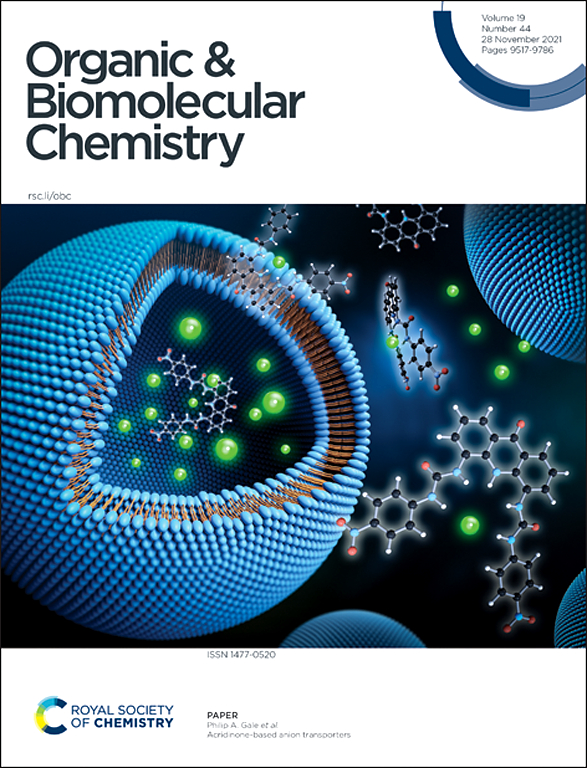Discovery of nostatin A, an azole-containing proteusin with prominent cytostatic and pro-apoptotic activity†
IF 2.7
3区 化学
Q1 CHEMISTRY, ORGANIC
引用次数: 0
Abstract
Ribosomally synthesized and post-translationally modified peptides (RiPPs) are intriguing compounds with potential pharmacological applications. While many RiPPs are known as antimicrobial agents, a limited number of RiPPs with anti-proliferative effects in cancer cells are available. Here we report the discovery of nostatin A (NosA), a highly modified RiPP belonging among nitrile hydratase-like leader peptide RiPPs (proteusins), isolated from a terrestrial cyanobacterium Nostoc sp. Its structure was established based on the core peptide sequence encoded in the biosynthetic gene cluster recovered from the producing strain and subsequent detailed nuclear magnetic resonance and high-resolution mass spectrometry analyses. NosA, composed of a 30 amino-acid peptide core, features a unique combination of moieties previously not reported in RiPPs: the simultaneous presence of oxazole/thiazole heterocycles, dehydrobutyrine/dehydroalanine residues, and a sactionine bond. NosA includes an isobutyl-modified proline residue, highly unusual in natural products. NosA inhibits proliferation of multiple cancer cell lines at low nanomolar concentration while showing no hemolysis. It induces cell cycle arrest in S-phase followed by mitochondrial apoptosis employing a mechanism different from known tubulin binding and DNA damaging compounds. NosA also inhibits Staphylococcus strains while it exhibits no effect in other tested bacteria or yeasts. Due to its novel structure and selective bioactivity, NosA represents an excellent candidate for combinatorial chemistry approaches leading to development of novel NosA-based lead compounds.

发现了一种含有唑的蛋白苷,具有显著的细胞抑制和促进凋亡活性。
核糖体合成和翻译后修饰肽(RiPPs)是具有潜在药理应用价值的有趣化合物。虽然许多 RiPPs 都是已知的抗菌剂,但对癌细胞具有抗增殖作用的 RiPPs 数量有限。在此,我们报告了从陆生蓝藻 Nostoc sp.中发现的鼻胞素 A(NosA),这是一种高度修饰的 RiPPs,属于腈水解酶类头端肽 RiPPs(proteusins),其结构是根据从产生菌株中回收的生物合成基因簇中编码的核心肽序列以及随后的详细核磁共振和高分辨率质谱分析确定的。NosA 由一个 30 个氨基酸的肽核心组成,具有以前未在 RiPPs 中报道过的独特分子组合:同时存在噁唑/噻唑杂环、脱氢丁啉/脱氢丙氨酸残基和一个鞘氨醇键。NosA 包含一个异丁基修饰的脯氨酸残基,这在天然产物中极为罕见。NosA 在低纳摩尔浓度下可抑制多种癌细胞株的增殖,同时不溶血。它能诱导细胞周期停滞在 S 期,随后线粒体凋亡,其机制不同于已知的管蛋白结合和 DNA 损伤化合物。NosA 还能抑制葡萄球菌菌株,但对其他受试细菌或酵母菌没有影响。由于其新颖的结构和选择性生物活性,NosA 是组合化学方法开发基于 NosA 的新型先导化合物的极佳候选物。
本文章由计算机程序翻译,如有差异,请以英文原文为准。
求助全文
约1分钟内获得全文
求助全文
来源期刊

Organic & Biomolecular Chemistry
化学-有机化学
CiteScore
5.50
自引率
9.40%
发文量
1056
审稿时长
1.3 months
期刊介绍:
Organic & Biomolecular Chemistry is an international journal using integrated research in chemistry-organic chemistry. Founded in 2003 by the Royal Society of Chemistry, the journal is published in Semimonthly issues and has been indexed by SCIE, a leading international database. The journal focuses on the key research and cutting-edge progress in the field of chemistry-organic chemistry, publishes and reports the research results in this field in a timely manner, and is committed to becoming a window and platform for rapid academic exchanges among peers in this field. The journal's impact factor in 2023 is 2.9, and its CiteScore is 5.5.
 求助内容:
求助内容: 应助结果提醒方式:
应助结果提醒方式:


